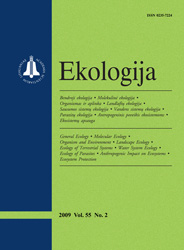Ekologija / Ecology
WHAT?
 ISSN 0235-7224 ISSN 2029-0586 (online) |
2011 m. Nr. 1 Modeling of temperate forest ecosystems’ plasticity limits
Data on the ability of forest plants and soil microorganisms to adjust their optimal and pessimal temperatures to environmental changes is discussed and modelled. Here we present also a conceptual model of an unusual heat wave impact on a temperate forest ecosystem – one of the most likely outcomes of climate warming. According to empirical data, optimal temperatures for plant growth differ from those favouring the growth of soil microorganisms, whereas differences between temperatures that are pessimal for both guilds are not significant. Therefore, if a heat wave strikes a temperate climate zone, the primary production of forests and local nutrient cycles are likely to suffer damage when air temperature reaches approximately the same limit, i. e. about 40 °C. The “plasticity margin” of several °C characteristics of temperate forests, most probably evidences that this climatic zone had been hit by warmings greater than the one observed presently. It is not unlikely, that the information on climate warmings that occurred in the comparatively recent past and that is similar to the predicted one, is still preserved in present-day populations of plants and not only. It has assumed the form of rare genes, genotypes (phenotypes) and species. Besides, it may have turned into silent loci and can be activated in the case of thermal stress.
Keywords: plants, soil microorganisms, climate change, heat wave, adaptation |
Issues:
2011 - Vol.57 No. 1, No. 2 2010 - Vol.56 No. 1-2, No. 3-4 2009 - Vol.55 No. 1, No. 2, No. 3-4 2008 - Vol.54 No. 1, No. 2, No. 3, No. 4 2007 - Vol.53 No. 1, No. 2, No. 2.priedas, No. 3, No. 4 2006 No. 1, No. 2, No. 3, No. 4 2005 No. 1, No. 2, No. 3, No. 4 2004 No. 1, No. 2, No. 3, No. 4 2003 No. 1, No. 2, No. 3, No. 4 2002 No. 1, No. 2, No. 3, No. 4 2001 No. 1, No. 2, No. 3, No. 4 |